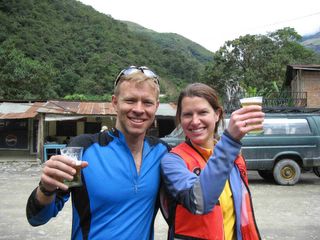Thursday, April 14, 2005
Wednesday, April 06, 2005
Is It Really the 'World's Most Dangerous Road'?
Three weeks ago, Dana and I signed up to spend a day mountain biking the "world's most dangerous road", a name given by the UN to a winding, muddy route cut into the side of the mountains between La Paz and Coroico. Hundreds of people drive or fall off the edge of the road every year and the government has spent the better part of a decade trying to build a safer route to help farmers in the lowlands get their crops to market.
Still, knowing how over-hyped "adventure" travel can be these days, I had my doubts about the seriousness of the 65-km downhill ride. The thought of descending from 16,000 feet to about 5,000 in the span of just a few hours was exciting, but "most dangerous road" seemed like overkill.
I changed my tune about half-way down, when the paved part of the road ended and we found ourselves hurtling down a muddy track full of semi-trucks, buses, and SUVs trying to squeeze past each other. Normally Bolivians drive on the right side, but to make sure the downhill drivers see exactly how close their tires are to the 1000-ft cliffs, they stay on the left. And so did we.
Ten kilometers into this muddy section, a landslide had completely buried the road, so we waited while two bulldozers precariously shoved a mountain of rubble over the cliff's edge. Further downhill, waterfalls cascading hundreds of feet crashed onto the road, speeding up an already rapid process of erosion.
The most dangerous parts of the road are often manned by volunteer lookouts waving red or green flags. They don't receive a salary, but are paid in tips by passing drivers. Nevertheless, crosses and memorials to the dead line most of the sharp turns. In some sections there are so many that they seem to serve as guardrails. Another one would soon be added. The next day, on our drive back to La Paz, we saw the wreckage of a bus that had gone over the edge with more than 40 passengers on board.
Clearly, the road's moniker is well-earned. And so was the beer that we downed at the end of the ride. But the real reward for such an unnerving trip is the little town of Coroico, where we ate freshly made pastas and curries while soaking in the warmth and tranquility of one of Bolivia's more charming pueblos. If you make it down here, and can handle the precarious roundtrip from La Paz, we'd love to show you around.

Peering over the edge (that's a 2-lane road behind us).

Tuesday, April 05, 2005
Friday, April 01, 2005
Beyond Bolivia
When Dana first told me - about a year ago - that moving to Bolivia might be an option for us, I had to plead almost complete ignorance about the country. I really knew just two things:
1. Bolivia is one of South America's only land-locked countries. (The other, for you Jeopardy fans, is Paraguay).
2. Bolivia is where Butch Cassidy and the Sundance Kid were killed after fleeing Argentina. I really need to see that movie again.
I doubt you were in any better shape when we finally told you our plans. Even in the midst of political turmoil here - the President did threaten to resign twice in two weeks, after all - I received an email from an editor in the U.S. saying "We can't run two Bolivia stories in one week. That's just too much."
So, as a result, I've had to branch out a bit. If you click on the title above you'll read my first take on a presidential summit that took place in Venezuela earlier this week.
And on a personal note, Dana and I just returned from a long Easter weekend in Bolivia's wine country. I'll try to post an update on that with some photos in the coming days. Keep checking back.


